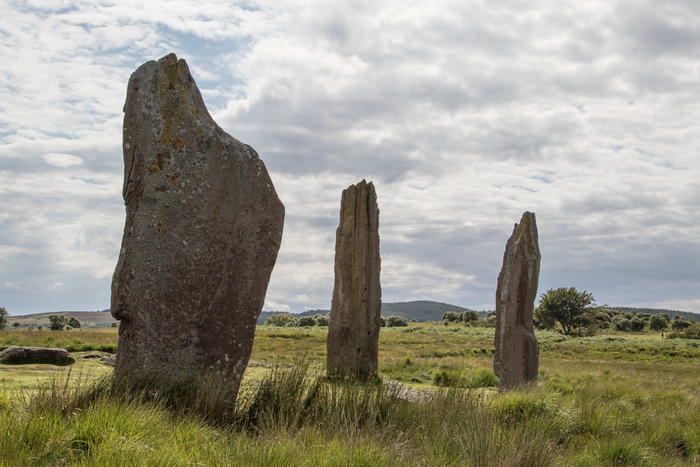The History of Arran: From Past to Present
The largest island in the Firth of Clyde, off the west coast of Scotland, the Isle of Arran has a rich history that dates back more than 200 million years ago. From ancient Neolithic settlements to mediaeval castles and beyond, the history of Arran is as diverse as its stunning landscapes.
Prehistoric past
On Kildonan shore, at the southern base of the island, visitors can step back in time to Arran’s prehistoric past. A large footprint - one of several on the island, and roughly 40 centimetres in length - is visible on the beach at low tide. Left by a land-living reptile named Chirotherium, this crocodile-like creature would have walked the area 270 million years ago when Arran was part of Pangea, a supercontinent that incorporated the majority of Earth’s landmass.
Archaeological evidence suggests that humans, primarily early hunters and fishermen, have inhabited the island since the Mesolithic Age, roughly 9,000 years ago. From the start of the Neolithic period (4,000 BC), environmental and social changes would have been noticeable on Arran with the introduction of the farming of crops and the building of monuments. Many Neolithic remnants can still be seen today in the form of standing stones, burial cairns, and stone circles - one of the most notable sites being the giant standing stones at Machrie Moor.

Several Bronze Age sites have also been excavated on the island, including a small roundhouse that was discovered on Coire a’ Bhradain, 384 metres above sea level. Using radiocarbon dating, it’s estimated the site would have been occupied between 1400-1300 BC, when it would likely have been used as a temporary shelter during hunting trips.
Gaels, religion and the arrival of the Vikings
Moving through the Bronze and Iron Ages, Arran became part of Dalriada (also known as Dál Riata), a Gaelic kingdom that occupied the western coast of Scotland and north-eastern Ireland from around 500-800. Hundreds of years later, Dálriada would form part of the Kingdom of Alba: what we know today as Scotland.
Religion would also take root on Arran around the same time as the arrival of the Gaels. In 545, a monastery was established by Saint Brendan, one of the Twelve Apostles of Ireland and the patron saint of sailors. Another early Irish saint, Saint Molaise of Leighlin, travelled to Holy Isle (likely known as Inis Shroin at the time or "Island of the Water Spirit") and lived a life of seclusion in a cave. Spirituality still plays an important role in life on Holy Isle today: the Centre for World Peace and Health - managed by an ordained monk - hosts a retreat during the summer season.
In the late 8th and early 9th centuries, Arran’s history took a dramatic turn with the arrival of the Vikings, who encompassed the island into Norway’s kingdom. These Norse invaders left a significant mark on the island, influencing its culture, language and place names. The name of the village of Brodick is derived from breda-vick, which means ‘Broad Bay’ and Goatfell is Old Norse in origin from Gait-fjall. The Vikings also left behind artefacts that continue to be discovered by archaeologists; in 1909 a cremation burial was found near Lamlash Bay that contained a whalebone plaque and a styca, a small coin minted in pre-Viking Northumbria.
Mediaeval Era
The Battle of Largs in 1263 between the kingdoms of Norway and Scotland marked the beginning of the end of Viking rule over western Scotland. However, the following centuries remained a turbulent period for Arran. The island was subject to frequent attacks from the English, as well as battles for power between warring clans.

This period on Arran is perhaps best evidenced in the history of Brodick Castle. The castle that exists today was designed in 1844, but there has been a fortress on this site for over 800 years, dating back to the kingdom of Dalriada. It has been captured by Edward I of England, recaptured in 1307 by James Douglas at the behest of Robert the Bruce and suffered damage from attacks by the English in 1406; in 1455 by John of Islay, Lord of the Isles; and in 1544 by an English force led by the Earl of Lennox on behalf of Henry VIII.
In 1503, James Hamilton was rewarded by James IV of Scotland for helping to arrange his marriage to Princess Margaret Tudor by being made Earl of Arran and took possession of Brodick Castle. The castle would stay in the ownership of the Hamilton family for more than 500 years, but it did change hands frequently in the 1600s as the Campbells battled for control. Today, Brodick Castle is owned by the National Trust for Scotland, and its house and grounds are open to the public.
The Modern Era
Economic and social changes characterised the modern history of the Isle of Arran as the island's economy saw a growth in more diversified activities away from farming. The Firth of Clyde supported fishermen for centuries; its waters contained an abundance of herring, pollock, cod and turbot. Until the last century, especially since the 1980s when fishing stocks in the Clyde suffered drastically from the use of trawl and dredge fishing vessels, Lochranza was one of the main herring fishing ports in West Scotland.
Arran also has a well-established past in whisky making, and in fact whisky smuggling. In the 1700s, many farmhouses would have had small, private stills, but in 1781 all private whisky production in Scotland was outlawed by the government, and wasn’t made legal again for another 40 years. Illicit whisky stills sprang up all over the island and smuggling operations were set up to transport Arran’s whisky - known as ‘Arran Waters’ - across the Firth of Clyde to be sold on the mainland.
When the law changed, a legal distillery operated at Lagg, but due to unsuitable infrastructure on the island and difficulties with transportation, it was closed in 1840. It would be over 150 years before Arran’s whisky distilling legacy was rekindled with the opening of Lochranza distillery in 1995. In 2019, we were thrilled to revive Lagg’s whisky heritage with the opening of Lagg distillery.

Present Day
Today, the Isle of Arran is a vibrant community that welcomes visitors from around the world. Fewer than 5,000 people live on the island, but over 4 million visitors step foot off the ferry every year. Its rich history is celebrated through museums, historical sites, and cultural festivals. The island's natural beauty, from rugged mountains to serene beaches, continues to captivate all who set foot on its shores.
If you’d like to learn more about Arran’s whisky heritage, why not join us on a whisky history tour? Stroll around Lagg Distillery, as one of our tour guides' regales you with the fascinating history of Arran’s distilling past, both illicit and licensed. You’ll also have the opportunity to savour some drams of Lagg’s single malts.


